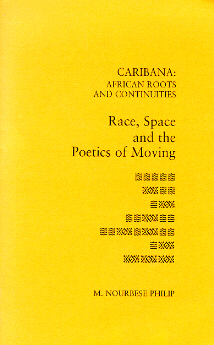 This work traces the history of Toronto’s Caribana, it’s model – the Trinidad Carnival, and other examples such as London’s Notting Hill event. NourbeSe Philip highlights carnival’s African origins, describes the role of the calypsonians, the pan yards the the marse bands and, of course, the ongoing role of the bekas (white people). More important than all of these though are the people. It is they who are the reason that carnival exists. Here they are typified by the characters Totoben and Amiss.
This work traces the history of Toronto’s Caribana, it’s model – the Trinidad Carnival, and other examples such as London’s Notting Hill event. NourbeSe Philip highlights carnival’s African origins, describes the role of the calypsonians, the pan yards the the marse bands and, of course, the ongoing role of the bekas (white people). More important than all of these though are the people. It is they who are the reason that carnival exists. Here they are typified by the characters Totoben and Amiss.
Like much of NourbeSe Philip’s work, this “essay” crosses genre boundaries. It includes poetry, has fictional characters like a short story and the whole essay is written in rhythm and language of the Trinidadian demotic.
The essay has the sub-title Race Space and the Poetics of Moving, and opens with the words:
sweat and jostle and
jostle and push
jostle and jostle
push and jostle and
and shove and move
to the pulse
riddim pan
riddim and beat
the beat
sweat like a ram goat
sweat for so
and push and shove and jostle and shove and move hip sway hip wine in your wine and look how we enjoying we self — move hip sway hip slap hip big hip fat hip flat bottom big bottom sweet bottom wine-your-waist bottom. Look we nuh, look how we enjoying we self right here in Canada self and Toronto sweet sweet too bad — but look me crosses! Is not Totoben that? Begging your pardon, Mr. Emmanuel Sandiford Jacobs himself, right here in Canada if you please, carrying on as if he don’t give a damn blast or shit.
…For six cold-no-arse months he up at five cold or no cold, travelling two hours straight, punching a clock, working like a robot…But he don’t mind, not Totoben, not today…for today Emmanuel Sandiford Jacobs dead dead and Totoben in full sway, riding high, riding hard on University Avenue, T-shirt pull up high high over his belly which big round black and shining like it carrying six months of baby in it a real don’t-give-a-damn belly that walking down University Avenue…
(p.1) ©M.Nourbese Philip 1996
What connecting Maisie and Totoben on the slave ship to Totoben and Maisie on University Avenue up in Canada is moving — the moving of their bodies. And the stopping of that moving. From the very first time when the Europeans putting them in the slave coffle in Africa, holding them in dungeons all along the coast of Ghana, and forcing Maisie and Totoben onto the slave ship, the owners trying and controlling their moving — where they going, what they eating, who they sleeping with. When Totoben and Maisie entering the slave ship, they having nowhere to move, and once again they moving under heavy manners. Once they landing in the New World — Brazil, Tobago, the United States anywhere, it don’t matter – is the same thing.
(p.4) ©M.Nourbese Philip 1996
You must be starting in 1838 if you wanting and understanding this thing that Totoben and Maisie doing; 1838, the year of emancipation for all the Totoben’s and Maisie’s in the English colonies; 1838 — four years after the apprenticeship period that starting in 1834 — when Totoben and Maisie finally free and doing what they wanting, eating what they wanting, drinking what they wanting, working where they wanting, walking where they wanting, and MOVING where they wanting, Or so Maisie and Totoben thinking.
(p.8) ©M.Nourbese Philip 1996
When the English beka (white people) banning the drum, Totoben and Maisie moving around that and using bamboo and making the tamboo bamboo bands and when beka banning tamboo bamboo Totoben and Maisie using biscuit tins and making biscuit tin bands; they using pieces of iron, parts of cars, metal boxes, dustbins and even piss pots, and all the time they moving towards pan and making their music through their moving.
(p15) ©M.Nourbese Philip 1996
This single essay volume is self published as a chap book through Poui Publications and can be ordered directly from the author. It has also been published in a collection of NourbeSe Philip’s essays, a Genealogy of Resistance and Other Essays, as well as several other anthologies
